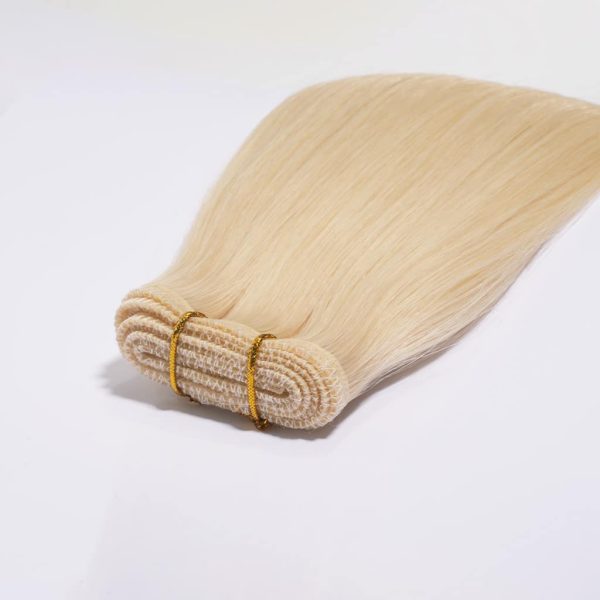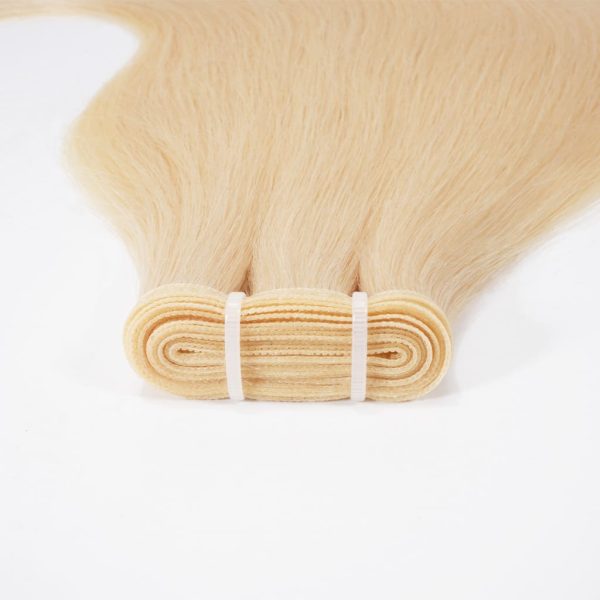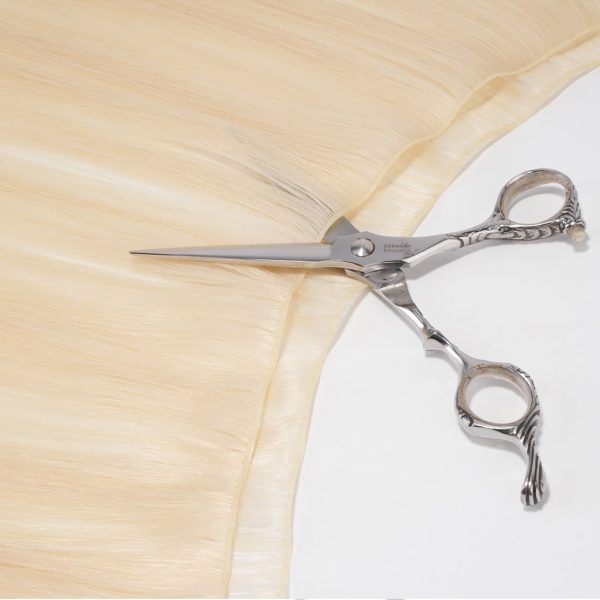Hand-tied and machine wefts are both hair wefts, only different by one word, yet they have caused drama unnecessarily.
A client once fed back to us that there were situations in which a customer walks into their salon asking particularly for a hand-tied weft extension but ended up getting a machine weft.
We’ve discussed some hair extension methods in previous posts, like fusion hair extensions, tape-in hair extensions, etc., and how to tell the difference between good and bad hair extensions.
In this one, we will focus on hand-tied vs. machine wefts: what are they? What are the pros and cons of different hair wefts? Familiarize yourself with the wefts and be confident about them; you will grant your customer peace of mind before they sit on your salon chair.
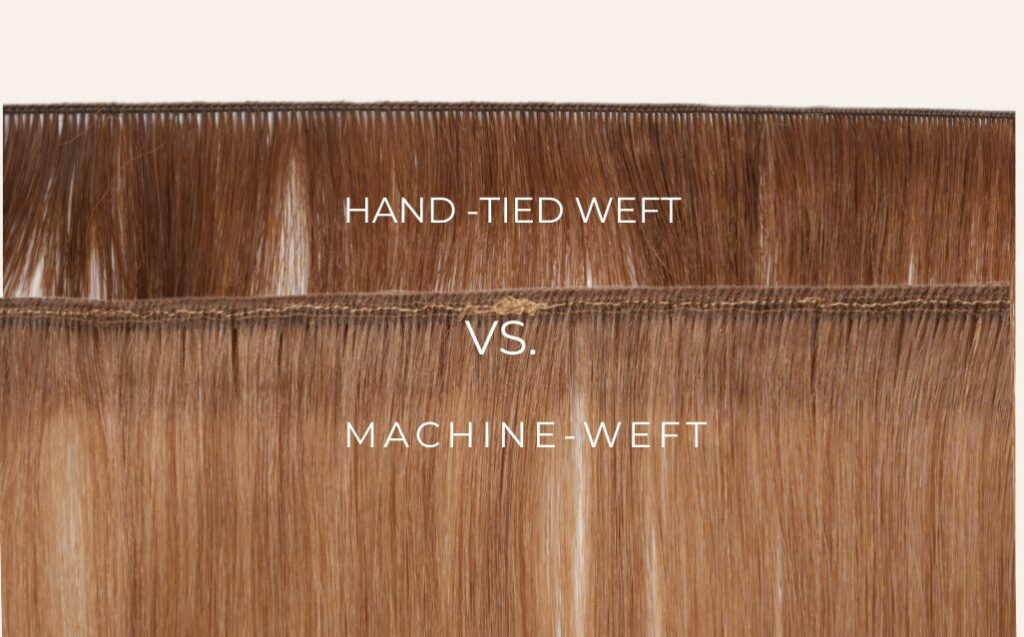
Subtypes of Sew-In Hair Extensions
Hand-tied and machine wefts are both hair wefts. They are subtypes of the sew-in hair extensions family. It’s sew-in or sew in, not sewin or red trout, the fish teeming in the Welsh waters.
Sew-in hair extensions, typically 24-inch sew-in hair extensions, as their name implies, are hair extensions that are technically sewn into the wearer’s natural hair, so the wearer doesn’t have to worry about slipping.
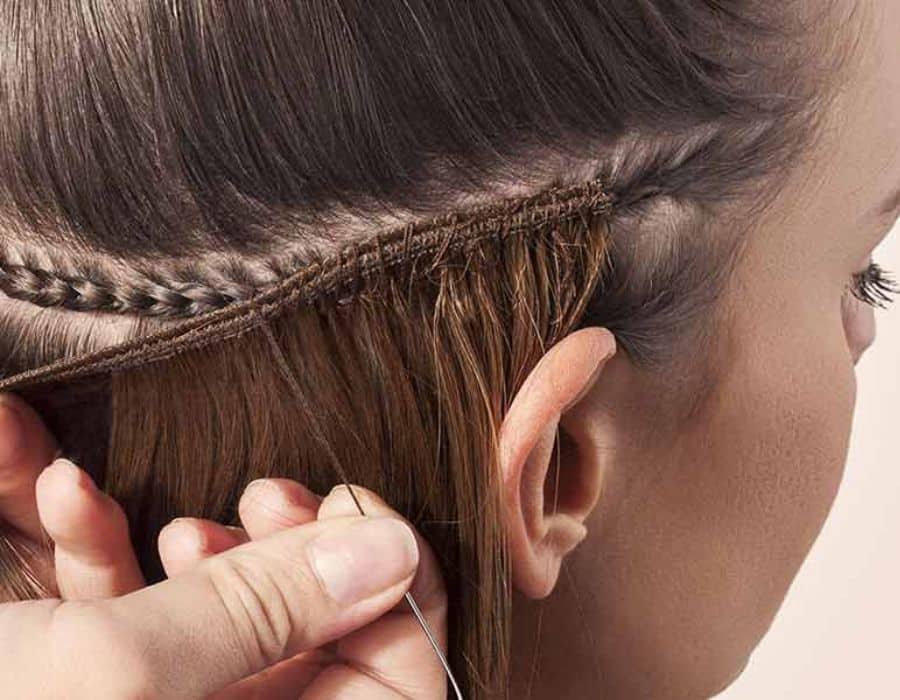
Sew-in Hair Extensions: Hair Wefts
Sew-in hair extensions or tie-in hair extensions are synthetic or human hair woven along a strip of cloth or PU skin to form a hair weft, and manually stitched to the wearer’s natural hair braids to achieve length or volume. Some also call them sewn-in hair extensions.
Differences Between Hand-Tied and Machine Wefts
Hair wefts are further subdivided into hand-tied and machine wefts (hybrid weft hair extensions are not included in this post). The essential difference is determined by how they are manufactured.
- Hand-Tied Wefts
Hand-tied hair extensions, as their name has it: are strands of hair woven along a strip of cloth or PU skin by hand.
Hand-tied wefts are significantly thinner and finer than machine-tied wefts, as the hair, cloth, or PU slip are sewn together by hand.
- Machine Wefts
Machine wefts, as their name implies, are strands of hair woven along the strip of cloth or PU skin by a sewing machine.
The sewing together of hair and the cloth or PU strip requires abundant hair to get caught by the machine, so machine wefts are significantly thicker.
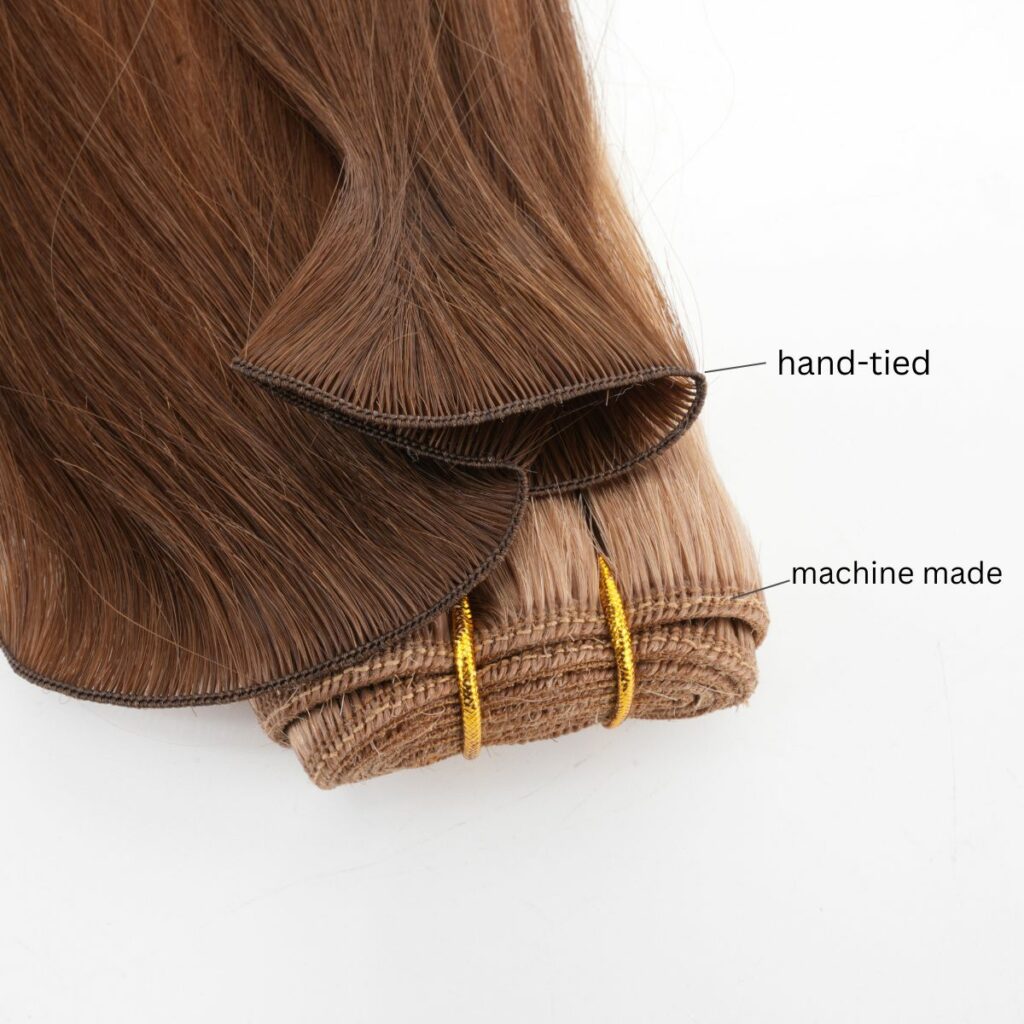
Difference Between Hand-Tied and Machine Wefts
Having explained the key difference between hand-tied and machine wefts, here are their pros and cons.
Joint Pros and Cons
Firstly, let’s put all wefts together and see what hand-tied and machine wefts are good at and not so good at:
Pro(s): Sturdy hold, the hair is sewn to the wearer’s natural hair, so it will never slip off. The way they get sewn to the natural hair also guarantees that the wearer doesn’t have to worry about undergrowth of natural hair.
Con(s): Unlike tape-ins, halos, and clip-ins, hair wefts are not a time and money-efficient hair extension method.
- Hand-Tied Wefts: Pros
- Hand-tied wefts are hand-tied. So they are thin, present the wearer with a smooth, sleek mane, natural, and seamless.
- Tied to the first advantage, hand-tied wefts are thin, so they are generally lightweight, put very little stress around the natural hair roots if worn correctly, an ideal choice for wearers with thin or fine hair.
- Some attaching methods, like IBE or beaded weft extensions, will ideally disguise the extensions, even with fine or thin hair.
- Hand-tied hair extensions can be attached in layers for vast styling and dyeing options.
- Hand-tied hair extensions have vast styling and dyeing options to match natural hair.
- Again for their thinness, hand-tied hair extensions can be attached to sectioned natural hair to create layers to spread weight evenly.
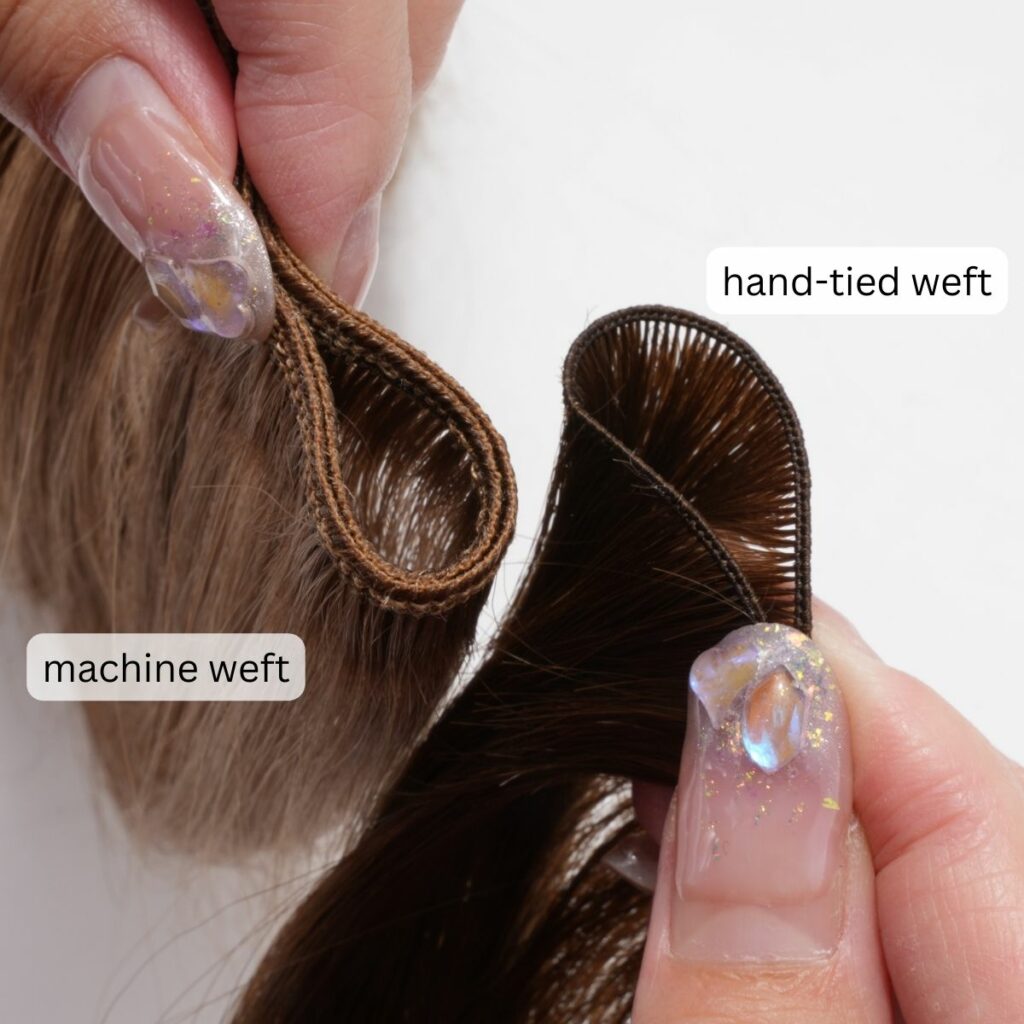
- Hand-Tied Wefts: Cons
- Hand-tied wefts must be moved once every 6-8 weeks as the wearer’s natural hair grows.
- Frequent brushing, combing, and other maintenance mechanisms are required to keep hand-tied hair extensions looking their best.
- Machine Wefts: Pros
- Machine wefts are cheaper than hand-tied wefts, as they are machine-made and take less time to make, which makes them less costly than hand-tied wefts.
- The tracks are thicker and more durable than hand-tied wefts, as they are machine-made. They generally shed less hair.
- Tied to the previous advantage, machine wefts are a great option for thick hair. They better thicken the hair with fewer wefts.
- Machine weft manufacturing costs less and takes less time, making it less labor-intensive throughout the manufacturing stage.
- Most Machine wefts can be cut to smaller sizes without fraying and applied piece by piece to the areas where volume or length is required.
- Machine Wefts: Cons
- They are thick, so they are heavier than hand-tied wefts, which could cause damage by pulling against natural hair.
- Bulky, this is also tied to their being much thicker. They can’t provide layers, not look as realistic as the hand-tied wefts.
- Opposite of hand-tied wefts, machine wefts are not as flexible as hand-tied wefts and don’t have many styling options.
Hand-tied vs. Machine Wefts: Which One Should You Go For?
Imagine this scenario a customer walks in, asking for a sew-in hair extension. Yes, she is asking for wefts. How are you going to pick the weft that will be a perfect fit for her? What questions are you going to ask?
As a stylist, you know that every client is unique, especially in terms of hair conditions.
Hair extensions are the same. One is different from the others. The varying types of hair extensions are also designed to suit various hair types. The same is also true for hair wefts.
Through hair extension consultations, you will gain a great understanding of your client’s hair type and decide with confidence what weft will be a perfect fit.
While both hand-tied and machine wefts may have been processed with chemicals, hair texture may not necessarily play a large part in decision-making. However, thinness and durability are the paramount attributes to consider when dealing with sew-in hair extensions.
Hand-Tied Wefts Are Fit for Thin, Fine Hair
Hand-tied extensions, being thin and lightweight, are the best choice for clients with thin or fine hair. As mentioned above, hand-tied wefts can be attached in layers and have a wide variety of styling options, which allows them to mix seamlessly with natural hair that no one can tell the wearer is wearing them.
Hand-tied weft extensions are also good for finer hair, as they can lay flat to the back of the head, making the whole head of hair seamless and voluminous.
With hand-tied hair wefts at New Times Hair, for example, there are over 10 colors available, ranging from black to light blonde. Their lengths are 14″ to 28″ (real human hair for sew-in hair extensions), super soft Remy human hair, from a single donor, the wearer can hardly feel the weight.
-
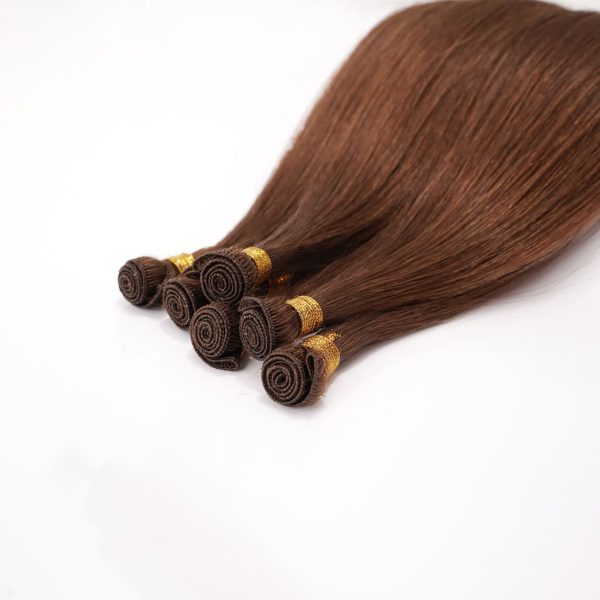 HAND-TIED WEFT Extension Wholesale Premium Remy Hair$66.00 – $345.00
HAND-TIED WEFT Extension Wholesale Premium Remy Hair$66.00 – $345.00
Machine Wefts Are Perfect for Thick or Coarse Hair
Machine wefts are perfect for clients with thick or coarse hair, which will easily hide the weft’s thick track. This means those with thinning or fragile hair should ideally avoid machine wefts for their weight.
New Times Hair weft hair extensions are made from 100% Remy human hair from a single donor, no other types of strands mixed. The hair is smooth, shiny, strong, and healthy.
Click to order weft hair extensions for professional use.
-
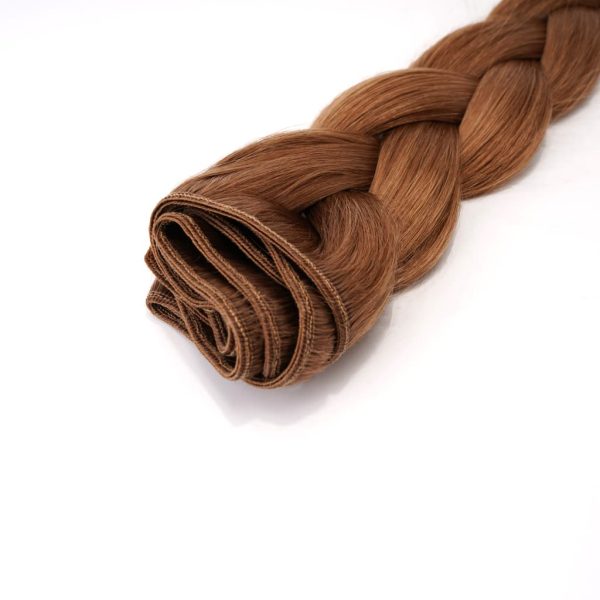 WEFT Hair Extensions Wholesale Remy Human Hair$45.00 – $172.50
WEFT Hair Extensions Wholesale Remy Human Hair$45.00 – $172.50
However, as qualified stylists, we can be flexible. We can use both types of hair wefts on one customer, e.g., hybrid wefts or a combination of hand-tied and machine wefts can be used on one person.
For example, stitching machine wefts to the back of the head and hand-tied wefts around the crown area where hair is more delicate. We will cover this in another post. Please keep an eye on our blog page.
Many stylists these days also choose wefts for customers depending on the size of their heads. If hand-tied wefts are too long, then switch to the machine ones, which can be cut accordingly. That said, most importantly, make sure the hair extension has the same density as the wearer’s natural hair, and be very careful when attaching them where hair is fragile.
With the progress of hairpiece manufacturing technologies, New Times Hair has also made thinner machine wefts. This flat weft is one of them, with over 10 colors available, plus ombre, piano, etc., mixed colors, and at a lower price.
Genius Wefts: a Weft Revolution
More and more stylists and salon owners are switching from hand-tied wefts to Genius wefts.
Genius wefts incorporate the benefits of both hand-tied and machine wefts. They are thin, lightweight, and have pretty much all the good attributes a hand-tied hair weft has.
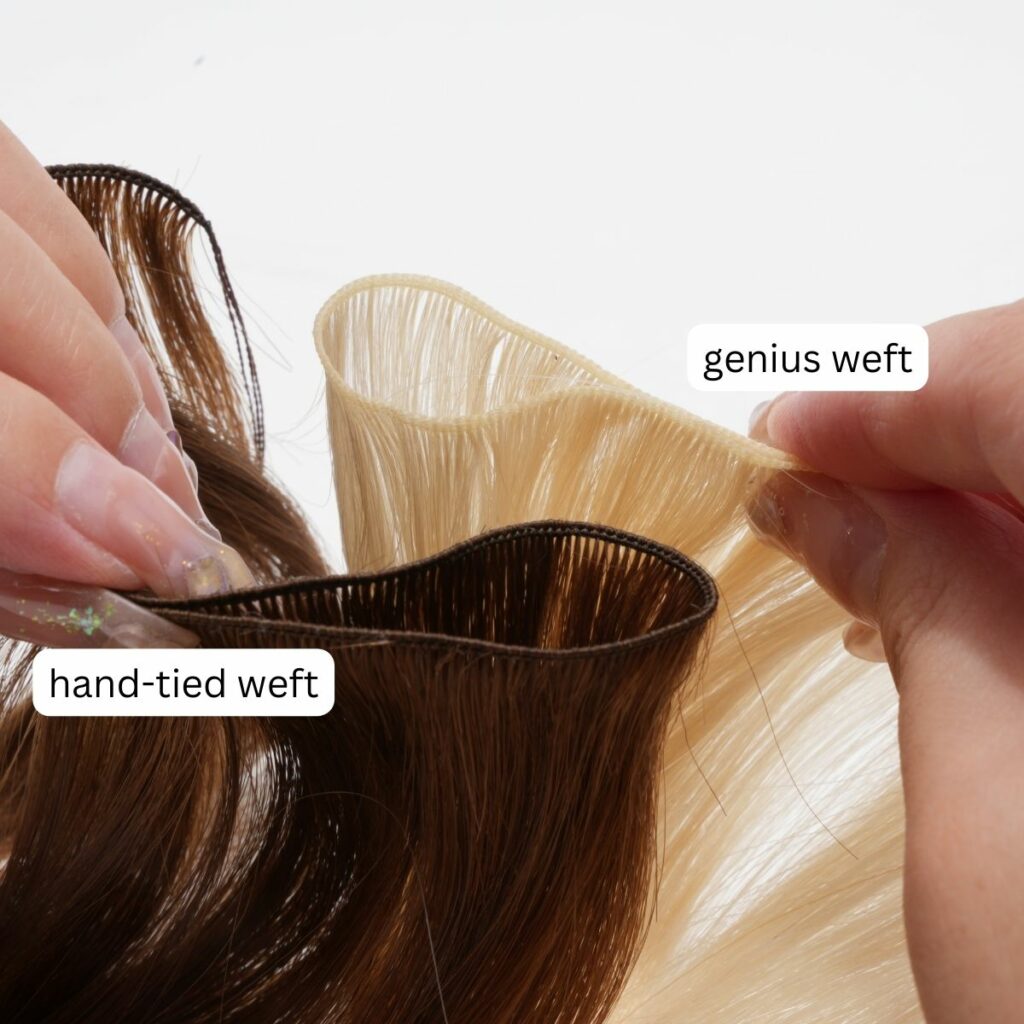
- Genius Wefts Can Be Reused and Are Durable
One thing that makes machine wefts stand out is that they are long-lasting and more robust than hand-tied wefts. They can be reused multiple times.
- Genius Wefts Have No Return Hair
Unlike hand-tied hair extensions, Genius wefts are perfectly smooth along the weft, with no return hair (or hair beard) showing. Return hair can tangle with the wearer’s natural hair or rub against the scalp, causing itchiness.

- Genius Wefts Can be Cut into Smaller Sizes
Unlike hand-tied extensions, Genius wefts are versatile. They can be cut into smaller pieces from anywhere on the weft without fraying to perfectly fit the wearer’s head size.
- Genius Wefts Shed Less Hair
Genius wefts do not shed hair as quickly as hand-tied wefts. Moreover, as tied to one of the previous benefits of being durable, Genius wefts grant all the benefits of machine wefts.
- Cost Effective
With all the benefits given, Genius wefts cost less to manufacture. As a matter of fact, they are genuinely identified as machine wefts. Yes, they are machine wefts made by a machine. And so they are not that expensive. Both you and your customers will love them for what they are and what they can help achieve.
Have a look at the top-quality Genius wefts at New Times Hair.
Final Thoughts
Hand-tied wefts beat machine wefts in many ways, in terms of their thinness, better mixing with natural hair, more styling options, lightweight, etc. On the other hand, machine wefts are more durable, cheaper, and can be cut into smaller pieces without fraying. But Genius wefts are a combination of all their excellent attributes. Shortly and likely, Genius wefts will dominate the global weft market.
Click here to view all top-quality weft hair extensions at New Times Hair.
